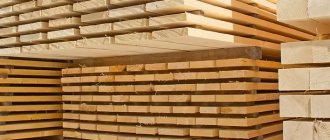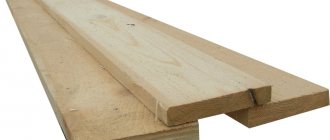3 .. Measurement and accounting of felled trees
Each tree can be divided into three parts: trunk, branches and roots. The ratio of these parts to each other in terms of mass varies depending on the breed, age and growing conditions.
Rice. 6. Shape of trees (I) and cross-section of the trunk (II): 1 - tree grown in a dense forest; 2 - in a forest of medium density; 3 - in a sparse forest; AB - largest diameter; CD - smallest
But, as a rule, the stem part makes up the main wood mass, which increases with age. Numerous observations have shown that in mature, closed stands the mass of stem wood is 60-85%, branches 5-25 and roots 5-30% of the total mass of the tree.
Table 1
The density of the tree stand has a very large influence on this ratio. The trunks in dense stands are taller and the shape in the first half of the tree is close to a cylinder, in rare ones they are stunted and have a more conical shape, and the crowns are usually large and spreading (Fig. 6). For example, in oak trees grown in the wild in the form of lighthouses, the mass of branches at the age of 50-60 years reaches 50% or more. The trunk of coniferous trees has the best development: spruce, fir, larch and pine.
Taxation characteristics of a tree trunk.
At the bottom the trunk resembles a cylinder, at the top it resembles a cone. To determine the volume of a cylinder and cone, you need to know their height and base area, which can be calculated from its diameter. To determine the volume of a trunk, you need to know its shape, height (length) and thickness (diameter). These elements are the main taxation characteristics of the trunk, and all the others are derived from them. In cross-section, a tree never gives a circle, but only approaches it, but for practical purposes, without any special errors, it is accepted as a circle. It must be remembered that the diameter of the tree must always be measured very carefully, taking it as the average of two mutually perpendicular diameters or from the largest and smallest (see Fig. 6). When determining the height of a felled trunk, it is practically not the length of its axis that is measured, but the curve forming the trunk, since the resulting error is extremely negligible.
Determination of trunk volume.
A felled tree, cleared of twigs and branches, forms a whip or trunk. The volume of a trunk is always less than the volume of a cylinder and greater than the volume of a cone of the same height and base area. By gradually reducing the diameter of the cylinder, you can find one at which its volume is equal to the volume of a tree trunk of the same height. Numerous studies have established that this diameter is approximately the diameter of the middle of the trunk. Therefore, to determine the volume of the trunk, you need to measure its length with a tape measure or other measuring instrument and the diameter in the middle with a measuring fork, then, using the measured diameter, calculate the area of the circle and multiply it by the length of the trunk. As a result, we obtain the volume of the measured trunk. In table 1 shows data for determining the volume of the trunk based on the measured median diameter and height (length). In table 1 shows the most common heights and median diameters of trunks. It can be extended both in length and in diameter. This kind of table is often called cylinder volume tables. Using the table is very simple. Example. It is required to determine the volume of two trunks with a length of 21 and 11 m with a median diameter of 17 and 12 cm, respectively. To determine the volume of the first trunk according to the table. 1 we find in the first column on the left the number 21 m and on this line a column with a diameter of 17 cm; where they intersect is the number 0.4767. This means that the required volume is 0.4767 m3. The volume of the second trunk is found at the intersection of line 11 and column 12 cm; it is equal to 0.1244 m3. -It should be noted that when determining the volume by the median diameter, significant errors are possible and in most cases towards an underestimation of the actual volume (sometimes over 10%), but the calculations are made easily and quickly and are quite acceptable for practical purposes. If the volume of the trunk needs to be calculated with greater accuracy, then it is divided into parts and for each of them the volume is determined by the median diameter and length. The shorter these parts are and the more they are cut out of the trunk, the more accurate the result can be obtained based on the total volume. Usually the trunk is divided into 2 sections (Fig. 7). The work is performed as follows. The trunk is marked using a tape measure on the 2nd segments with small notches in their middles, then in the places of the notches, the diameters are measured with a measuring fork and using the table. 1 and 2 find the volumes of all parts, the sum of which gives the volume of the trunk, excluding the top.
Rice. 7. Splitting the tree into 2nd sections
In table Figure 2 shows the volumes of the 2nd segments along the median diameter. The volume of a peak less than 2 m long is usually so small that it is practically not taken into account. The volume of the vertex is calculated using the formula for the volume of a cone - multiplying the area of the base by */3 of the height, i.e. the area of the base should be multiplied by the length and the resulting product divided by three. In table Figure 3 shows data for determining the required volume based on the measured diameter of the base of the apex and its length. Example. You need to find the volume of a trunk 22 m long. The median diameters of the 2 segments are equal: the first (1 m from the bottom segment) 41; second (3 m) 37; third (5 m) 34; fourth (7 m) 31; fifth (9 m) 29; sixth (11 m) 27; the seventh (13 mU 24; the eighth (15 m) 21; the ninth (17 m) 17 and the tenth (19 m) 12 cm. The diameter of the base of the top (2 m long) is 8 cm.
When starting to build a house or make renovations, sometimes you have to face questions that seem simple at first glance, but you can’t answer them right away. It seems awkward to approach specialists with such a question, but you need to know for sure. For those who can go online, it’s easier - type in a search engine “How much does a cube of wood weigh” and in half a minute get a comprehensive result. By the way, really, how much?
The effect of humidity on the weight of wood
The weight of wood does not always have the same value. What does it depend on? First of all, from the moisture content of the wood. If we compare, for example, oak and birch, it turns out that a cubic meter of oak weighs 700 kg, and a birch weighs 600 kg. But it could be different. Weighing a cubic meter of birch, we get 900 kg, and oak will show the same 700. Or in both cases it will be 700 kg. Why do we get such different numbers? In this case, the moisture content of the wood plays a role.
There are four degrees of humidity: dry (10-18%), air-dry (19-23%), damp (24-45%) and wet (above 45%). Thus, it turns out that different rocks with the same humidity have different weights, as in the first example above. If the humidity is not the same, then the weight may fluctuate in one direction or another. The standard humidity is 12%.
Requirements for different types of foundation
A solid foundation is the basis of a log house. Despite the fact that the weight of wall structures of such timber is lighter than that of stone ones, it must be strong, so its calculation is carried out during the design.
Geological and hydrological surveys are preliminarily carried out . Since the choice of type depends not only on the weight load of log structures, but also on:
- soil characteristics;
- the depth of its freezing;
- groundwater level;
- amount of financing.
The latter circumstance allows you to choose a cheap pile, medium strip or expensive slab foundation.
The influence of the weight of pine logs of natural moisture on the size of the foundation can be seen using the example of calculating a 6x6 m house on sandy soil.
For example, for a summer cottage with a tree thickness for load-bearing walls of 200 mm, the weight of the timber in the house will be :
- pine walls D200: 6x4x3x0.2x810 = 11664 kg;
- roof: 2.6 m3 x 620 kg/m3 = 1612 kg;
- floor and ceilings: 4.3 3 x 620 kg/m3 = 2666 kg;
- operational load for the roof: 36 m2x105.0 kg/m2=3780.0 kg;
- floors 36 m2x210.0 kg/m2=7560.0 kg;
- total load 27282 kg.
The snow load for the roof is 50 m3, according to the table it is determined for the 3rd zone , which corresponds to the Moscow region, it is equal to 180 kg/m3, then:
- 50 m3 x 180 =9000 kg.
- Wind load for 36 m3 with a house height of 5 m: (15.0x5 +40) x36 = 4176 kg.
- Amount: 27282 kg+9000 kg+4176 kg =40458 kg.
- Taking into account the error safety factor in calculation 1.2, the weight is determined to be 48550 kg. For sandy soil with a bearing capacity of 2 kg/cm3, the preferred type of foundation is strip, its base size for these walls: 48550 2 = 24275 cm3.
- The length of all walls, including one internal load-bearing 6x4+6=30 m, 3000 cm.
- In this case, the smallest width of such a base is: 24550/3000 = 8.18 cm.
- Since the width of the load-bearing walls is 20.0 cm, the width of the foundation should be at least 30 cm, and the depth will depend on the level of freezing. This size of foundation will be enough to withstand the weight of 200 mm of logs - 11664 kg with a threefold margin.
- If you choose a log thickness of 30 cm, then similarly the weight of the walls will be D300: 6x4x3x0.3x810 = 17496 kg.
- Total weight of the house structures: 17496+1612+2666+3780+7560= 33094 kg.
- Amount with atmospheric loads: 33094 kg + 9000 kg + 4176 kg = 46270 kg.
- Taking into account the margin of 1.2, the load on the foundation is 55524 kg.
- Area of the base for these walls: 55524 2 =27762 cm3.
- Length of all walls, including one internal load-bearing wall: 6x4+6=30 m=3000 cm.
- The smallest width of such a foundation is: 27762/3000 = 8.25 cm, since the width of the load-bearing walls is 30 cm, the width of the foundation, the width of the base should be taken at least 40 cm, and the depth will depend on the level of freezing.
This size of foundation will be enough to support the weight of 300 mm logs, 17496 kg, with a fourfold margin.
Heat transfer from wood
In addition, there is another indicator - heat transfer. It will come to the aid of those who use wood as firewood for heating. The higher the hardness, i.e. The density of the wood species, the higher its calorific value. Of course, no one will heat a room with boxwood, but when choosing between linden and pine or birch and acacia, you can get much more heat if you know which of these species is the hardest. Information about the density of each tree can be gleaned from the tables, since all this information is systematized for ease of use.
Weight of a dense cubic meter, kg
| Breed | Humidity, % | |||||||||||
| 10 | 15 | 20 | 25 | 30 | 40 | 50 | 60 | 70 | 80 | 90 | 100 | |
| Beech | 670 | 680 | 690 | 710 | 720 | 780 | 830 | 890 | 950 | 1000 | 1060 | 1110 |
| Spruce | 440 | 450 | 460 | 470 | 490 | 520 | 560 | 600 | 640 | 670 | 710 | 750 |
| Larch | 660 | 670 | 690 | 700 | 710 | 770 | 820 | 880 | 930 | 990 | 1040 | 1100 |
| Aspen | 490 | 500 | 510 | 530 | 540 | 580 | 620 | 660 | 710 | 750 | 790 | 830 |
| Birch: | ||||||||||||
| - fluffy | 630 | 640 | 650 | 670 | 680 | 730 | 790 | 840 | 890 | 940 | 1000 | 1050 |
| - ribbed | 680 | 690 | 700 | 720 | 730 | 790 | 850 | 900 | 960 | 1020 | 1070 | 1130 |
| - Daurian | 720 | 730 | 740 | 760 | 780 | 840 | 900 | 960 | 1020 | 1080 | 1140 | 1190 |
| - iron | 960 | 980 | 1000 | 1020 | 1040 | 1120 | 1200 | 1280 | — | — | — | — |
| Oak: | ||||||||||||
| - petiolate | 680 | 700 | 720 | 740 | 760 | 820 | 870 | 930 | 990 | 1050 | 1110 | 1160 |
| - eastern | 690 | 710 | 730 | 750 | 770 | 830 | 880 | 940 | 1000 | 1060 | 1120 | 1180 |
| — Georgian | 770 | 790 | 810 | 830 | 850 | 920 | 980 | 1050 | 1120 | 1180 | 1250 | 1310 |
| - Araksinian | 790 | 810 | 830 | 850 | 870 | 940 | 1010 | 1080 | 1150 | 1210 | 1280 | 1350 |
| Pine: | ||||||||||||
| - cedar | 430 | 440 | 450 | 460 | 480 | 410 | 550 | 580 | 620 | 660 | 700 | 730 |
| - Siberian | 430 | 440 | 450 | 460 | 480 | 410 | 550 | 580 | 620 | 660 | 700 | 730 |
| - ordinary | 500 | 510 | 520 | 540 | 550 | 590 | 640 | 680 | 720 | 760 | 810 | 850 |
| Fir: | ||||||||||||
| - Siberian | 370 | 380 | 390 | 400 | 410 | 440 | 470 | 510 | 540 | 570 | 600 | 630 |
| - white-haired | 390 | 400 | 410 | 420 | 430 | 470 | 500 | 530 | 570 | 600 | 630 | 660 |
| - whole leaf | 390 | 400 | 410 | 420 | 430 | 470 | 500 | 530 | 570 | 600 | 630 | 660 |
| - white | 420 | 430 | 440 | 450 | 460 | 500 | 540 | 570 | 610 | 640 | 680 | 710 |
| - Caucasian | 430 | 440 | 450 | 460 | 480 | 510 | 550 | 580 | 620 | 660 | 700 | 730 |
| Ash: | ||||||||||||
| - Manchurian | 640 | 660 | 680 | 690 | 710 | 770 | 820 | 880 | 930 | 990 | 1040 | 1100 |
| - ordinary | 670 | 690 | 710 | 730 | 740 | 800 | 860 | 920 | 980 | 1030 | 1090 | 1150 |
| - acute-fruited | 790 | 810 | 830 | 850 | 870 | 940 | 1010 | 1080 | 1150 | 1210 | 1280 | 1350 |
The table shows average mass values. Possible maximum and minimum mass values are 1.3 and 0.7, respectively, from its average value
For me, this question was a quiet horror; it was completely incomprehensible to me that how they were calculated, how they were calculated, although I had read a lot of articles. In simple terms, maternity pay is calculated to you a couple of weeks after going on maternity leave, it is calculated based on your income for the last 2 years before going on maternity leave, the maximum in 2015 was 219,000 thousand, and on maternity leave monthly payments begin to be transferred at the end of maternity leave, this period is indicated on the sick leave and up to 1.5 years, the maximum amount in 2016 is 19 thousand and kopecks. If you had a caesarean section, for example, then at work you are paid for sick leave and it is extended during the maternity leave period, that is, monthly payments are also postponed.
—
Missing the deadline established for appealing the decision of the labor dispute commission is not a basis for refusing to accept the application. Having recognized the reasons for the absence as valid, the court may restore this period and consider the dispute on the merits. If the deadline is missed for no good reason, the application remains without consideration and, accordingly, the decision of the labor dispute commission remains a factor.
—
Yes, and the registration of the buyer’s ownership of the apartment in the mortgage occurs simultaneously with the registration of the mortgage itself. The sales and purchase agreement and the loan agreement are submitted to the registration authority. The registration period for real estate credit transactions in Moscow is 7 calendar days. As a result, you will receive a registered agreement with two stamps of the registry office - on the registration of your ownership of the apartment and on the registration of the mortgage by force of law. In the register of rights to real estate, two rights will be registered for one piece of real estate - your property and the creditor's pledge.
—
The situation is serious - the new owner in this case risks being left without everything. And there are plenty of examples. A friend of mine had a case. He bought a car for 450 thousand rubles and became its third owner. I didn't check the car when I bought it. A year later, bailiffs showed up and explained that the car was the property of the bank. The first owner stopped paying the loan, and the bailiffs decided to take the car. A friend had to pay someone else’s debt of 200 thousand rubles in order to keep his car. Later it turned out that the previous owner did not even know that the vehicle was pledged.”
—
In the section Other areas of business, to the question People, can someone tell me, can I, a citizen of Belarus, open an individual entrepreneur on the territory of the Russian Federation? And what you need to do? asked by the author Vladimir Kachan the best answer is this Any capable citizen who has reached the age of majority can engage in entrepreneurial activity, except for civil servants and military personnel. Persons with limited legal capacity (those who abuse alcohol or drugs, as well as minors aged 14 to 18 years) can engage in entrepreneurial activities only with the consent of their legal representatives. The status of an individual entrepreneur is possible not only for citizens of the Russian Federation, but also for foreign citizens, as well? for stateless persons.
Wood has been used in construction work since ancient times.
Of course, this material is still very popular due to its excellent technical characteristics. Wood itself is a natural material of a structured type, consisting of wood cells and pericellular voids, which in turn does not at all guarantee that one part of the wood will be equal to another of identical size. Therefore, so often, in the process of work, the question arises of calculating the required amount of a given material and such parameters as: the weight of the wood as a whole and the weight of a cube of wood. Weight of wood species depending on the type in the table
| Wood species | Humidity percentage, % | ||||||||||
| Fresh | 100 | 80 | 70 | 60 | 50 | 40 | 30 | 25 | 20 | 15 | |
| Larch | 940 | 1100 | 990 | 930 | 880 | 820 | 770 | 710 | 700 | 690 | 670 |
| Poplar | 700 | 760 | 690 | 650 | 610 | 570 | 540 | 500 | 480 | 470 | 460 |
| Beech | 960 | 1110 | 1000 | 950 | 890 | 830 | 780 | 720 | 710 | 690 | 680 |
| Elm | 940 | 1100 | 1100 | 930 | 880 | 820 | 770 | 710 | 690 | 680 | 660 |
| Oak | 990 | 1160 | 1160 | 990 | 930 | 870 | 820 | 760 | 740 | 720 | 700 |
| Hornbeam | 1060 | 1330 | 1330 | 1130 | 1000 | 990 | 930 | 860 | 840 | 830 | 810 |
| Norway spruce | 740 | 750 | 750 | 640 | 600 | 560 | 520 | 490 | 470 | 460 | 450 |
| Walnut | 910 | 1000 | 1000 | 850 | 800 | 750 | 700 | 650 | 630 | 610 | 600 |
| Linden | 760 | 830 | 830 | 710 | 660 | 620 | 580 | 540 | 540 | 530 | 500 |
| White acacia | 1030 | 1330 | 1330 | 1190 | 1060 | 990 | 930 | 860 | 840 | 830 | 810 |
| Alder | 810 | 880 | 880 | 750 | 700 | 660 | 620 | 570 | 560 | 540 | 530 |
| Maple | 870 | 1160 | 1160 | 990 | 930 | 870 | 820 | 760 | 740 | 720 | 700 |
| Common ash | 960 | 1150 | 1150 | 930 | 920 | 860 | 800 | 740 | 730 | 710 | 690 |
| Siberian fir | 680 | 630 | 630 | 540 | 510 | 470 | 440 | 410 | 400 | 390 | 380 |
| Scots pine | 820 | 850 | 850 | 720 | 680 | 640 | 590 | 550 | 540 | 520 | 510 |
| Caucasian fir | 720 | 730 | 730 | 620 | 580 | 550 | 510 | 480 | 460 | 450 | 440 |
| Cedar pine | 760 | 730 | 730 | 620 | 580 | 550 | 510 | 480 | 460 | 450 | 440 |
| Birch | 870 | 1050 | 1050 | 890 | 840 | 790 | 730 | 680 | 670 | 650 | 640 |
| Aspen | 760 | 830 | 830 | 710 | 660 | 620 | 580 | 540 | 530 | 510 | 500 |
Depending on the type of construction work, wood needs to be measured differently. The density of the material has a special significance on the weight of m3 of wood; accordingly, to correctly solve the questions posed, it is necessary to determine the value of the density. There are two types of density:
Specific gravity (density of wood substance)
Volumetric weight (density of a structured physical body)
Wood substance is a mass of solid wood materials without natural voids. This type of density is measured in laboratory conditions, as it requires additional measurements that are impossible under normal conditions. For each wood of all types and species of trees, this value is constant and amounts to 1540 kg/m3.
The density of the wood itself is quite easy to determine under normal conditions. To do this, just weigh a piece of wood and measure its volume. Process the obtained data using standard arithmetic operations using the following formula: Y = M/O, where Y is the specific gravity of the tree, M is the mass of the wood, O is the occupied volume.
How to calculate the volume of a log?
- Determine the type of calculation : number of pieces in cubes (cube) or pieces in cubes;
- Choose the first option if you need to calculate the amount of logs in a cube (for example, how much is in 1 m3);
- Choose the second option if you need to calculate the volume of the selected amount of logs;
Table of volumetric weight of 1m3 of wood depending on humidity.
The density of wood matter, as already said, is a constant. However, wood has a multicellular fibrous structure of a complex type. Walls made of wood substance play the role of a frame in the structure of wood. Accordingly, for each tree species and species, the cellular structures, shapes and sizes of cells vary, as a result of which the specific gravity of the tree will be different, as well as the different weight of m3 of the tree.
Also, humidity plays a big role in changing the specific gravity of wood. Due to the structure of this material, with increasing humidity, the density of wood also increases. However, this rule does not apply to the density of wood substances.
Below is the specific gravity of wood. The table is compiled depending on the moisture content of the material and is calculated using an indicator such as the weight of 1m3 of wood.
When organizing timber transportation, the density of the tree is an important indicator when selecting a timber truck and calculating the cost of transportation. This will help avoid overloading, which will consequently prevent you from being fined.
The density of the material has a special significance on the weight of m3 of wood; accordingly, to correctly solve the questions posed, it is necessary to determine the value of the density. There are two types of density: volumetric weight
(density of the structured physical body) and
specific gravity
(density of the wood substance).
What is a cubic meter
This value is usually used to measure gas, water, snow, sand and other bulk and liquid materials.
However, this value is only suitable for measuring one whole piece of wood, for example, pine: after all, if you fold a cube of individual firewood and boards, there will still be a distance between them, albeit a few millimeters.
It is important to know: in construction, the cubic capacity of wood is also measured in cubic meters: this is necessary when transporting and storing building materials.
Consequently, when purchasing firewood, boards and other “non-pillar” pieces, cubic meters are not suitable: you would have to measure each block from all sides and try to fit them within the given parameters. This is too long and can still lead to errors.
Specific gravity of wood
Wood substance is a mass of solid wood materials without natural voids. This type of density is measured in laboratory conditions, as it requires additional measurements that are impossible under normal conditions. For each wood of all types and species of trees, this value is constant and amounts to 1540 kg/m3. However, wood has a multicellular fibrous structure of a complex type. Walls made of wood substance play the role of a frame in the structure of wood. Accordingly, for each tree species and species, the cellular structures, shapes and sizes of cells vary, as a result of which the specific gravity of the tree will be different, as well as the different weight of m3 of the tree.
Also, humidity plays a big role in changing the specific gravity of wood. Due to the structure of this material, with increasing humidity, the density of wood also increases. However, this rule does not apply to the density of wood substances.
Table of wood densities of different humidity levels (kg/m3).
| № | Wood species | Humidity percentage, % | ||||||||||
| 15 | 20 | 25 | 30 | 40 | 50 | 60 | 70 | 80 | 100 | Fresh* | ||
| 1 | Larch | 670 | 690 | 700 | 710 | 770 | 820 | 880 | 930 | 990 | 1100 | 940 |
| 2 | Poplar | 460 | 470 | 480 | 500 | 540 | 570 | 610 | 650 | 690 | 760 | 700 |
| 3 | Beech | 680 | 690 | 710 | 720 | 780 | 830 | 890 | 950 | 1000 | 1110 | 960 |
| 4 | Elm | 660 | 680 | 690 | 710 | 770 | 820 | 880 | 930 | 990 | 1100 | 940 |
| 5 | Oak | 700 | 720 | 740 | 760 | 820 | 870 | 930 | 990 | 1050 | 1160 | 990 |
| 6 | Hornbeam | 810 | 830 | 840 | 860 | 930 | 990 | 1060 | 1130 | 1190 | 1330 | 1060 |
| 7 | Norway spruce | 450 | 460 | 470 | 490 | 520 | 560 | 600 | 640 | 670 | 750 | 740 |
| 8 | Walnut | 600 | 610 | 630 | 650 | 700 | 750 | 800 | 850 | 900 | 1000 | 910 |
| 9 | Linden | 500 | 530 | 540 | 540 | 580 | 620 | 660 | 710 | 750 | 830 | 760 |
| 10 | White acacia | 810 | 830 | 840 | 860 | 930 | 990 | 1060 | 1190 | 1300 | 1330 | 1030 |
| 11 | Alder | 530 | 540 | 560 | 570 | 620 | 660 | 700 | 750 | 790 | 880 | 810 |
| 12 | Maple | 700 | 720 | 740 | 760 | 820 | 870 | 930 | 990 | 1050 | 1160 | 870 |
| 13 | Common ash | 690 | 710 | 730 | 740 | 800 | 860 | 920 | 930 | 1030 | 1150 | 960 |
| 14 | Siberian fir | 380 | 390 | 400 | 410 | 440 | 470 | 510 | 540 | 570 | 630 | 680 |
| 15 | Scots pine | 510 | 520 | 540 | 550 | 590 | 640 | 680 | 720 | 760 | 850 | 820 |
| 16 | Caucasian fir | 440 | 450 | 460 | 480 | 510 | 550 | 580 | 620 | 660 | 730 | 720 |
| 17 | Cedar pine | 440 | 450 | 460 | 480 | 510 | 550 | 580 | 620 | 660 | 730 | 760 |
| 18 | Birch | 640 | 650 | 670 | 680 | 730 | 790 | 840 | 890 | 940 | 1050 | 870 |
| 19 | Aspen | 500 | 510 | 530 | 540 | 580 | 620 | 660 | 710 | 750 | 830 | 760 |
*Fresh. — Freshly cut tree
How many cubic meters of firewood are there in ZIL
The Internet is often asked how many cubic meters of firewood a ZIL can hold. But there are no good articles on this topic. We decided to be the first and answer how much can fit in the 130th.
It should be said that there are several modifications of ZIL that are used to transport firewood. This could be the 131st, the flatbed 130th, or the ZIL Boat dump truck marked 555. And the firewood can also be stored in the 554th. This is also a dump truck, but with a regular square body.
In terms of carrying capacity, all vehicles from the plant named after. Likhachev are the same. They take on board up to 5 tons of cargo. If the driver does not spare the car, it will load 6.5 tons. Based on the weight of the wood, we can say that the car can take away 7-8 cubic meters of birch.
All ZIL models have different platform sizes. Accordingly, different amounts of wood fit into them.
Model 6520 - cubic capacity
This is a fairly new truck. You can distinguish it by its restyled bright orange cabin and large body.
Firewood is rarely transported in it. Such huge trucks are designed for transporting sand, crushed stone and other bulk materials.
This KAMAZ has a special feature. It comes out of the factory in two versions. With standard side heights and increased ones. Standard body dimensions: 4878 mm by 2300 mm by 1098 mm. 12.3 cubic meters of firewood will fit there. If the plant increases its height, the volume will increase to 20m3.
The load capacity of the machine is 20 tons. With overload they carry 21-22 tons.
Based on the tonnage, the car can carry 26 cubes of birch and 24 m3 of oak with natural moisture. Dry firewood can take: 44 m3 of birch, 36 cubic meters of oak and 48 m3 of alder.
https://www.drovavoz.ru/skolko-drov-v-kamaze.html — link
How many cubic meters of firewood are in KAMAZ
There is little material on this topic on the Internet. The authors copy each other, which does not add credibility to the articles. It seems like you are reading the same article on different sites. When you read that such and such a truck carries such and such a volume, this information is obviously unreliable.
Let's figure out how much firewood is included in KAMAZ.
We must start with the fact that, firstly, KAMAZ trucks are different. The most popular are 4 modifications:
- Model 55111 is the popular name for “scoop”.
- Model 55102, popularly known as “collective farmer”.
- The 5320 is a flatbed version of the regular flatbed truck.
- 20-ton dump truck marked 6520.
Other models are rare when delivering firewood; we will not consider them.
Secondly, drivers increase the height of the body. To take away more. Some increase the height by 2 times. And the firewood is heaped up. Small vehicles are capable of transporting huge volumes.
Thirdly, the tonnage of KAMAZ trucks is different. They write on the Internet that the 55111th has a lifting capacity of 13 tons. However, the authors forget that machines produced before 1987 lifted 10 tons.
Drivers install reinforced springs. And a 10 tonic can lift 13 tons, and a 20 tonic, all 22 tons.
How much firewood is in a tractor cart?
Firewood is delivered not only by KAMAZ, ZIL, and Gazelles. Sometimes they are carried in tractor carts. Such transport is common in small towns and numerous villages.
There are many trailers (carts) for tractors. But the most common is a biaxial one with the marking 2PTS-4. 5-6 years ago an updated version appeared under the label 2PTS-4.5.
Tractor trailers differ in volume and load capacity. Therefore, you can answer the question of how much firewood is in the cart from two positions.
From the perspective of the contained volume. And from the point of view of the weight that it can lift if the sides are increased.










